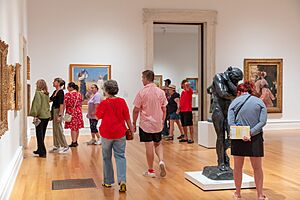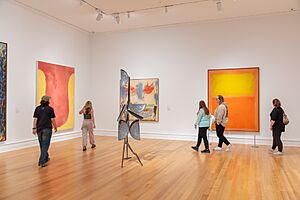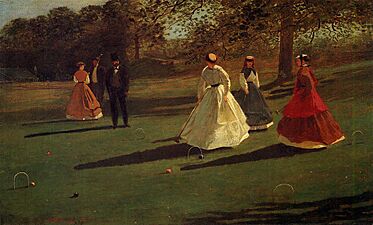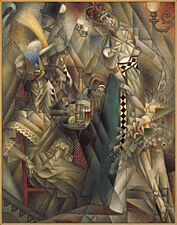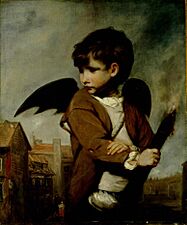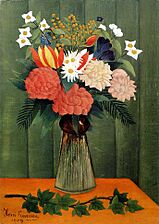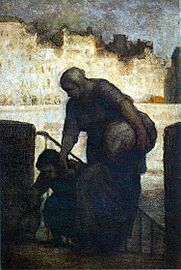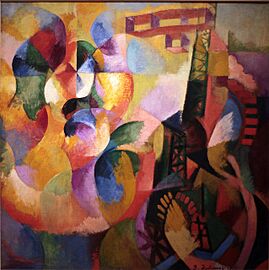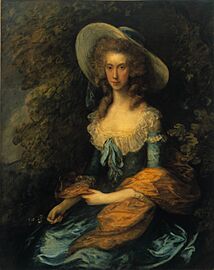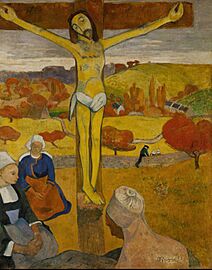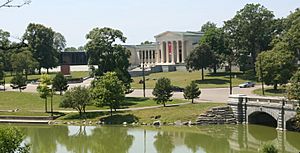Buffalo AKG Art Museum facts for kids
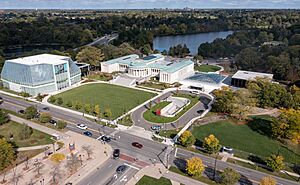
Aerial view of the Buffalo AKG Art Museum (October 2024)
|
|
| Established | May 31, 1905 |
|---|---|
| Location | 1285 Elmwood Avenue, Buffalo, New York |
| Type | Art museum |
| Architect | Augustus Saint Gaudens, Edward Brodhead Green Gordon Bunshaft (1962) Shohei Shigematsu (2023) |
| Nearest parking | Underground |
| Designated | May 27, 1971 |
| Reference no. | 71000538 |
The Buffalo AKG Art Museum is a cool place in Buffalo, New York, where you can see amazing modern art and contemporary art. It's right next to Delaware Park.
This museum used to be called the Albright–Knox Art Gallery. It got its new name from three important people who gave a lot of money to support it: John J. Albright, Seymour H. Knox II, and Jeffrey Gundlach.
Contents
A Look at the Museum's Past
The Buffalo AKG Art Museum started with an organization called the Buffalo Fine Arts Academy, which began way back in 1862. It's one of the oldest public art groups in the United States!
How the Museum Began
In 1900, a rich businessman from Buffalo named John J. Albright gave money to build an art gallery. A local architect, Edward Brodhead Green, designed the building. It was supposed to be ready for a big event called the Pan-American Exposition in 1901. But it wasn't finished until 1905. When it finally opened on May 31, 1905, it was called the Albright Art Gallery.
Adding More Buildings
The museum campus has several buildings. Clifton Hall was built in 1920. After some updates, it became the Albright Art School in 1929. It was named after Charles Clifton, who helped fund its renovation.
In 1962, the museum grew even more thanks to Seymour H. Knox II and his family, along with many other generous people. This new part was designed by Gordon Bunshaft, a famous architect. At this time, the museum changed its name to the Albright–Knox Art Gallery. The Buffalo AKG Art Museum is also a special historic place listed on the National Register of Historic Places.
Modern Updates and a New Name
The museum started planning for more space in 2001. In 2016, they chose an architect named Shohei Shigematsu to design a big expansion. Jeffrey Gundlach, a businessman from Buffalo, gave a huge donation of $42.5 million for the project. Many other businesses and people also helped raise money.
Because of Gundlach's gift, a new building was named the Jeffrey E. Gundlach Building. When all the renovations were finished and the museum reopened in spring 2023, it was renamed the Buffalo AKG Art Museum. The "AKG" stands for Albright, Knox, and Gundlach, honoring these important donors.
Cool New Features
The Seymour H. Knox Building used to have an open courtyard that visitors couldn't enter. Now, it has a cool artwork called Common Sky by artists Ólafur Elíasson and Sebastian Behmann. It's like a glass and mirror roof that lets light in and shows reflections. This new space is called the "Ralph C. Wilson, Jr. Town Square."
Clifton Hall now holds the museum's old records, offices, and a special study center for prints and drawings. It also has workspaces for the Public Art Initiative, which brings art to the community.
The Seymour H. Knox Building also has fun places for visitors. The Creative Commons is where you can join art workshops. It's the first time the Lego Foundation has worked with a museum! There's also a restaurant called Cornelia with a huge glass mosaic by artist Firelei Báez.
The Jeffrey E. Gundlach Building, which opened in August 2023, is a round glass building. It added over 50,000 square feet of new space for art and five classrooms. The first floor shows Scandinavian art, and the third floor displays the museum's newest art pieces.
The museum is also part of the Monuments Men and Women Museum Network, which helps protect art around the world.
Awesome Art Shows
The Buffalo AKG Art Museum has hosted many exciting art shows over the years.
In 1910, the museum had a special show about photography, put together by Alfred Stieglitz. It was one of the first times an American museum showed photography as a serious art form.
Later, in 1978, an exhibition of Richard Diebenkorn's art from the museum was chosen to represent the United States at a big international art event in Venice, Italy. The museum also sent an exhibition by artist Jenny Holzer to Venice in 1988.
What's in the Collection?
The Buffalo AKG Art Museum is known for collecting important artworks rather than many pieces by the same artist. It has a huge collection of over 6,500 works!
Art from Different Eras
You can see art from the 1800s in styles like Impressionism and Post-Impressionism. Artists like Paul Gauguin, Edgar Degas, Claude Monet, and Vincent van Gogh have works here.
The museum also has revolutionary art from the early 1900s, including abstract, cubism, surrealism, and constructivism. Look for pieces by Pablo Picasso, Henri Matisse, Joan Miró, Piet Mondrian, and Frida Kahlo (her famous Self-Portrait with Monkey is here!).
Thanks to Seymour H. Knox and a former director, Gordon M. Smith, the museum was one of the first to collect a lot of Abstract Expressionism. You'll find works by artists like Jackson Pollock, Joan Mitchell, and Helen Frankenthaler. The museum has the second-largest collection of paintings by Clyfford Still, with 33 of his abstract works.
Modern and Contemporary Art
The museum also has many examples of post-war American and European art. You can see pop art, minimalism, and art from the late 20th century by artists like Robert Rauschenberg, Jasper Johns, and Andy Warhol.
When pop artist Marisol passed away in 2016, she left all her art to the museum. This made it the largest collection of her work anywhere!
The contemporary collection includes pieces by artists like Cory Arcangel, Nick Cave, and Anselm Kiefer. Before its recent expansion, the museum could only show about 3% of its huge collection at one time.
Cool Art Highlights
Here are some of the amazing artworks you can find at the museum:
Paintings to See
-
Thomas Eakins, Music, 1904
-
Paul Gauguin- Manao tupapau (The Spirit of the Dead Keep Watch).JPG
Paul Gauguin, Spirit of the Dead Watching, 1892
-
Albert Gleizes, L'Homme au Hamac (Man in a Hammock), 1913
-
William Hogarth, The Lady's Last Stake, 1759
-
Winslow Homer, Croquet Players, 1865
-
Pierre-Auguste Renoir 056.jpg
Pierre-Auguste Renoir, Small Nude in Blue, 1879
-
Joshua Reynolds Cupid as Link Boy, c. 1771-1777
-
Henri Rousseau, Bouquet of Flowers with an Ivy Branch, 1909
-
Alfred Sisley, Village Street in Marlotte, 1866
-
Vincent van Gogh, La Maison de la Crau (The Old Mill), 1888
-
Honoré Daumier, Laundress on the Quai d'Anjou, c. 1860
-
Jacques-Louis David, Portrait of Jacques-François Desmaisons 1782
-
Robert Delaunay, Soleil, Tour, Aéroplane (Sun, Tower, Airplane), 1913
-
Thomas Gainsborough, Portrait of Miss Evans, c. 1786-1790
-
Paul Gauguin, The Yellow Christ, 1889
Here are a few more famous paintings in the collection:
| Name | Artist | Year | Notes |
|---|---|---|---|
| Hotel Lobby | Max Beckmann | 1950 | |
| Music and Literature | William Michael Harnett | 1878 | |
| La Maison de la Crau (The Old Mill) | Vincent van Gogh | 1888 | |
| La Jeune bonne (The Servant Girl) | Amedeo Modigliani | 1918 | |
| Self-Portrait with Monkey | Frida Kahlo | 1938 | |
| Nude Figure | Pablo Picasso | 1909-1910 | |
| La Toilette | Pablo Picasso | 1906 | |
| Chemin de haulage à Argenteuil (Tow path at Argenteuil) | Claude Monet | 1875 | |
| Convergence | Jackson Pollock | 1952 | |
| Icarus | Richard Hunt | 1956 | |
| Orange and Yellow | Mark Rothko | 1956 | |
| Winter Light | Norman Carton | 1956 | |
| Cow | Andy Warhol | 1976 |
Sculptures to Explore
The museum grounds also have many cool sculptures outside. Here are some of them:
| Name | Artist | Year | Image |
|---|---|---|---|
| Alphabet Series | Fletcher Benton | N/A | |
| Big Red | James Rosati | 1971 | |
| Bond | Alexander Liberman | 1969 | |
| Stainless Steel, Aluminum, Monochrome I, Built to Live Anywhere, at Home Here | Nancy Rubins | 2011 | |
| Cigarette | Tony Smith | 1961 | |
| Diamond I of III | Antoni Milkowski | 1967 | |
| Directional I | Lyman Kipp | 1962 | |
| Karma | Do-Ho Suh | 2010 | |
| E.C. Column | Kenneth Snelson | 1969–81 | |
| Flat Rate II | Lyman Kipp | 1969 | |
| Four Chances | Kenneth Snelson | 1982 | |
| Into the Blue | Shayne Dark | 2005 | |
| Laura | Jaume Plensa | 2012 | |
| Look and See | Jim Hodges | 2005 | |
| Shark Girl | Casey Riordan Millard | 2014 | |
| Stacked Revision Structure | Liam Gillick | 2005 | |
| The Cry | Isamu Noguchi | 1962 | |
| Turning the World Upside Down #4 | Anish Kapoor | 1998 |
Visiting the Museum
The museum is open from 10 AM to 8 PM on Thursdays and Fridays. On Saturdays, Sundays, and Mondays, it's open from 10 AM to 5 PM. On the first Friday of every month, you can pay what you wish to get in, thanks to M&T Bank.
Who Runs the Museum?
Since 2013, Janne Sirén has been the director of the Buffalo AKG Art Museum. He is the first director from the Nordic region to lead a major American art museum.
Past Directors
Here's a list of the people who have led the museum:
- Janne Gallen-Kallela-Sirén (2013–present)
- Louis Grachos (2002–2013)
- Douglas G. Schultz (1983–2002)
- Robert T. Buck, Jr. (1973–1983)
- Gordon M. Smith (1955–1973)
- Edgar C. Schenck (1949–1955)
- Andrew C. Ritchie (1942–1949)
- Gordon B. Washburn (1931–1942)
- William M. Hekking (1925–1931)
- Cornelia Bentley Sage Quinton (1910–1924)
- Charles McMeen Kurtz (1905–1909)
How the Museum Gets Money
The museum has a special fund called an endowment, which helps pay for new art and operations. In 2007, the museum sold an old Roman sculpture, Artemis and the Stag, for $28.6 million. This money helped the museum buy even more new art.
In 2013, the museum received a large gift of $11 million from Peggy Pierce Elfvin. Then, in 2016, Jeffrey Gundlach gave $42.5 million, which was the biggest donation from one person in the museum's history! These gifts help the museum continue to grow and bring amazing art to everyone.
See also
 In Spanish: Museo Albright-Knox para niños
In Spanish: Museo Albright-Knox para niños
- John J. Albright
- Portrait of Seymour H. Knox
- Seymour H. Knox II


